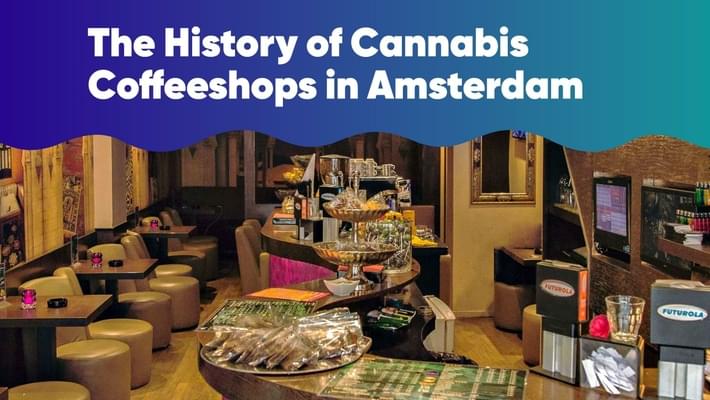
The History of Cannabis Coffeeshops in Amsterdam
Published on 12/31/22
Amsterdam is a haven for cannabis lovers around the globe. In Amsterdam, coffee shops are not serving up lattes and cappuccinos like coffee shops in the rest of the world. Instead, coffee shops in the Netherlands actually serve up legal cannabis to its consumers, offering everything from joints to dabs, depending on where you choose. Like coffee shops anywhere, each place has its own vibe: from dance club music and huge clouds of blunt smoke to chilled-out acoustic covers and petite puffs off your daintiest pipe, you're sure to find a coffee shop that matches your style. Whether you're planning the stoner adventure of your dreams or just daydreaming about what could be, this piece will cover the history of cannabis in Amsterdam, how and when coffee shops started, and what going to a Netherlands coffee shop is actually like.
The History of Cannabis in Amsterdam
The history of Amsterdam's modern cannabis and psychoactive drug culture begins in the 1960s. America's national countercultural movement, or the "hippie" craze, of the same era, was immensely inspirational to the Dutch country. As young people began to question and abandon the traditionally constraining cultural norms of modern American life, they pursued a new life philosophy that emphasized freedom, peace, and creativity, along with psychedelic drugs. This shift eventually influenced the Dutch government's stance on anti-drug laws.
In the Netherlands, "street drug" laws were traditionally quite strict, partially because the opioid and heroin epidemic was falsely equated with the increased popularity of psychoactive drugs amongst this beatnik group. Due to this spread of heroin addiction across the country, the Dutch government cracked down on eradicating it from the street supply and de-prioritized their policing of cannabis.
The Dutch use the term "gedogen," meaning that even when something is officially illegal, the police won't necessarily enforce it if it will ultimately lead to negative societal results. Pursuing cannabis was still on the police's agenda, but they prioritized harder crimes. Enforcing cannabis laws was a waste of resources when the government cracked down on the heroin trade. In fact, they found a total lack of cannabis trade could lead to an increase in heroin use because harder drug dealers would gain more power on the streets, leaving former users to turn to opium and heroin, only worsening the epidemic.
In 1976, the government revised the Opium Act, marking a clear distinction between "substances posing great risks to the health of the individual" (like opium and heroin) and "cannabis products," which, we can assume, does not. This revision solidified the guidelines set in 1969. The Ministry of Health addressed the addiction cycle with a pretty liberal approach. Instead of putting drug users in jail, they prioritized health and recovery treatment.
Coffee Shop History
In the 1980s, cannabis coffee shops began to grow in popularity as a place for people to enjoy this essentially decriminalized drug amongst friends and in a safe, regulated environment. In 1991, the government finally issued specific regulations for coffee shops in Amsterdam. These rules stated that shops couldn't sell or hold hard drugs on the premises, like opium, heroin, or cocaine. They also barred excessive marketing, signs, or wayfinding so as not to disturb the aesthetic of their respective neighborhoods. They set the legal age limit to purchase cannabis to 18 years old and set the maximum transaction size to 30 grams of cannabis per customer.
Once the heroin epidemic became more manageable, the government shifted its focus to regulating cannabis even more. In 1995, they issued a policy that continued to recognize the difference between hard drugs and cannabis as previously established, but it restricted the freedom they once enjoyed in an attempt to restore the city's "moral" center.
Legality
Dutch officials knew, though, not to overburden coffee shops with harsh cannabis laws because their cities were making hundreds of millions of Euros from the industry. They also feared that if cannabis lost its popularity, thanks to this crackdown, people would resort back to using hard drugs on the street.
To meet a middle ground, the government introduced the "weed pass" in 2012, allowing only registered locals to purchase cannabis goods from coffee shops to avoid weed leading to a cannabis-heavy tourist culture in the region. Locals soon turned against this policy because they wanted to retain anonymity and did not want their names registered in the system. The "weed pass" was soon abolished four years later in most major cities except for Maastricht and a few other small towns.
Today, Amsterdam is a mecca for stoners around the globe to enjoy sensible drug policy and live in a world free from cannabis stigma. It has also become an excellent way to meet others who share your affinity for the plant. Now that cannabis has become a keystone of the Dutch economy, coffee shops will likely remain a staple of the city for the foreseeable future.
The Coffee Shop Experience
Going to an Amsterdam coffee shop is sure to be a life-changing experience for stoners who have always had to hide their use in the shadows. A budtender will help you choose your perfect match with plenty of strains and consumption methods. While some coffee shops lean into the cafe vibe of their names, some of the best coffee shops in Amsterdam also act as traditional bars, uniting fans of the plant and alcohol alike. One of these is the famous Bulldog. What began as a living room for friends to secretly smoke a joint soon became the city's first coffee shop. For a more modern choice, Barney's Coffeeshop Amsterdam has won multiple High Times Cup awards and is Amsterdam's most original and futuristic coffee shops.
